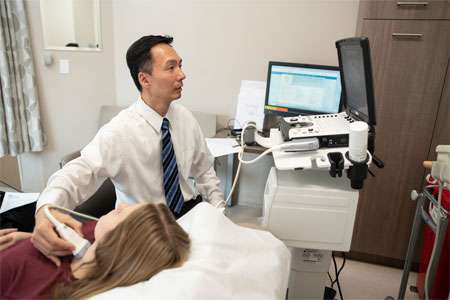Thyroid Cancer
Find your care
We deliver effective, minimally invasive treatments in a caring environment. Call 310-267-7838 to connect with an expert in endocrine surgery.
Thyroid Cancer
What is Thyroid Cancer?
Thyroid cancer forms when normal thyroid cells undergo genetic changes that cause them to grow in an abnormal way. The most common types of thyroid cancer (papillary and follicular) are typically less aggressive than other cancers.
There are multiple types of thyroid cancer:
- papillary thyroid cancer
- follicular thyroid cancer
- medullary thyroid cancer
- poorly differentiated thyroid cancer
- anaplastic thyroid cancer
Types of Thyroid Cancer
Papillary Thyroid Cancer
Papillary thyroid cancer (PTC) is the most common type of thyroid cancer, making up approximately 80% of all thyroid cancers. Papillary cancer tends to grow slowly and may spread to the lymph nodes in the neck, but still usually has an excellent prognosis. Most patients with papillary thyroid cancer can be successfully treated with a thorough initial operation, and some patients may require additional treatment with radioactive iodine. Most people are cured (over 95%) and have a normal life expectancy.
Follicular Thyroid Cancer
Follicular thyroid cancer (FTC) is the second most common type of thyroid cancer, making up 10-15% of all thyroid cancers. It may spread to the lymph nodes in the neck, and is also more likely than papillary thyroid cancer to spread through the blood stream to distant areas (such as the lungs). The prognosis for follicular thyroid cancer remains very good – over 90% of patients are cured.
Hurthle Cell Thyroid Cancer
Hurthle cell cancer is a rare type of follicular thyroid cancer that has many pink-staining cells (so-called oncocytes or Hurthle cells). The pathologist will look for signs of cancer cells invading into surrounding blood vessels or breaking outside of the thyroid, which may predict that the cancer will behave more aggressively.
Poorly-Differentiated and Anaplastic Thyroid Cancers
Poorly differentiated and anaplastic (also known as undifferentiated) thyroid cancer means that the cancer cells do not look or behave like normal thyroid cells. Patients usually present with a rapidly growing neck mass. These are very rare types of thyroid cancer, and occur in less than 2% of cases. Unfortunately, they tend to be very aggressive and not responsive to treatment. Management of these cancers involves a multi-disciplinary team with surgeons, endocrinologists, and medical oncologists. At UCLA, these patients may be treated with recently approved targeted therapies, immunotherapy, or clinical trials.
Medullary Thyroid Cancer
Medullary thyroid cancer (MTC) makes up 5-10% of all thyroid cancer cases. It is often associated with hereditary conditions (MEN-2), and all patients should undergo genetic testing for a RET gene mutation. If a mutation is found, then the patient’s family members may be at risk for medullary thyroid cancer. In addition, new targeted therapies are available for RET-mutated MTC.
Thyroid Cancer Treatment
Thyroid cancer treatment is very successful. About 95% of thyroid cancer patients live more than five years, and most thyroid cancer patients experience a normal life span and full quality of life after appropriate treatment. Even patients with advanced thyroid cancer may often do well with modern targeted therapies. The key components of thyroid cancer treatment for most types of thyroid cancer are surgery, thyroid stimulating hormone suppression, and ongoing surveillance of tumor markers with dynamic risk stratification. Patients with a high risk of disease recurrence may also be offered radiation therapy with radioactive iodine. Newer targeted therapies and immunotherapy may be used for patients with advanced and metastatic disease outside of the neck.
Key Components of Differentiated* Thyroid Cancer Management
- Thyroid Surgery
- Thyroid stimulating hormone suppression
- Radioactive iodine ablation (in some patients)
- Dynamic Risk Stratification informed by ongoing surveillance with tumor markers and imaging
* Differentiated thyroid cancer includes Papillary, Follicular, and Hurthle cell thyroid cancer. Treatment for poorly differentiated, anaplastic, and medullary thyroid cancers are distinct and discussed separately.
Special Populations with Thyroid Cancer

As a referral center for difficult cases, we also have experience in treating patients with special circumstances.
Genetic Syndromes
We are also part of specialized teams that care for patients and their families with:
- Multiple Endocrine Neoplasia (MEN-1, MEN-2A, MEN-2B, MEN4)
- Familial pheochromocytoma
- Von-Hippel-Lindau